tire type MAZDA MODEL B3000 TRUCK 2006 User Guide
[x] Cancel search | Manufacturer: MAZDA, Model Year: 2006, Model line: MODEL B3000 TRUCK, Model: MAZDA MODEL B3000 TRUCK 2006Pages: 266, PDF Size: 2.11 MB
Page 135 of 266
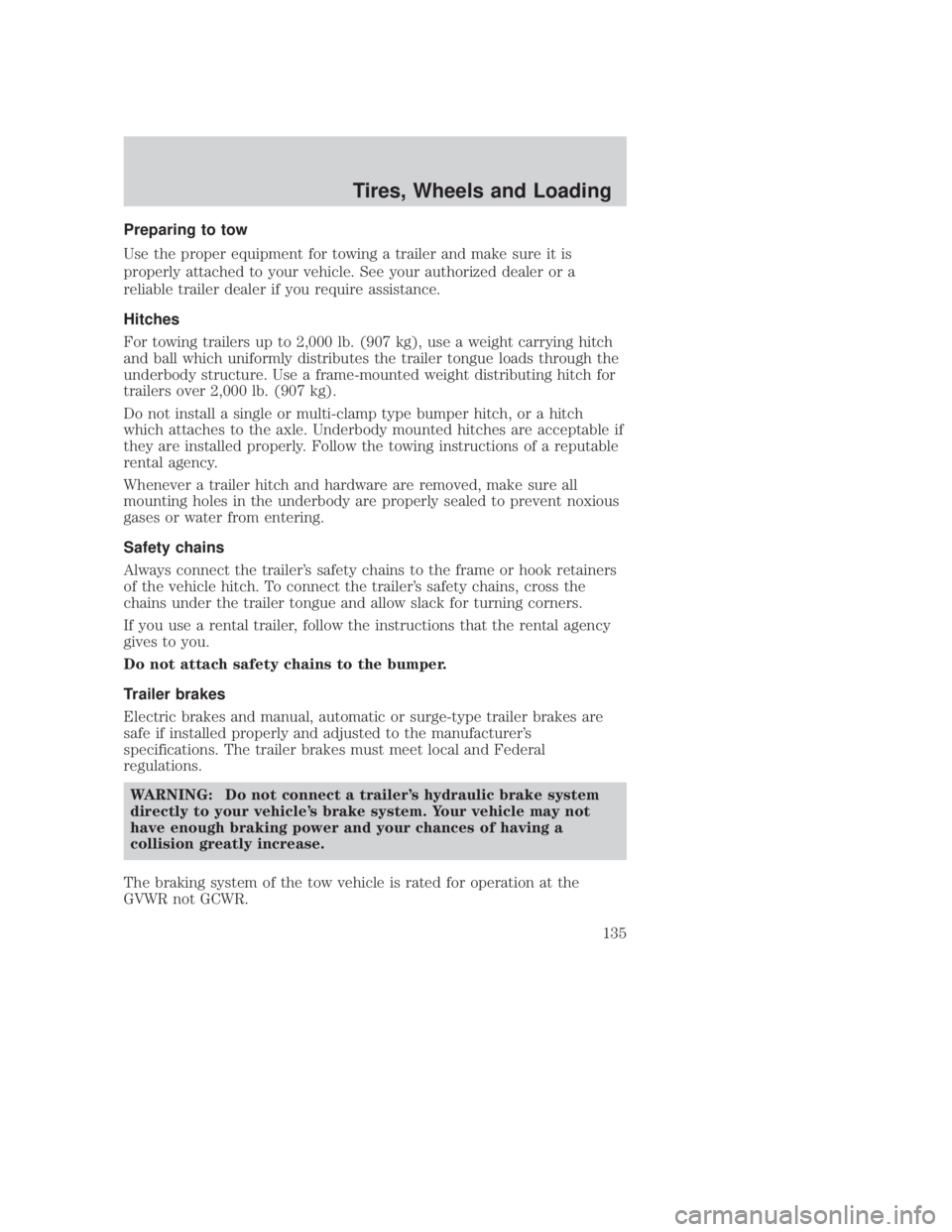
JOBNAME: No Job Name PAGE: 135 SESS: 1 OUTPUT: Thu Sep 15 08:22:27 2005
/ford_pdm/ford/own2002/mbs/og
Preparing to tow
Use the proper equipment for towing a trailer and make sure it is
properly attached to your vehicle. See your authorized dealer or a
reliable trailer dealer if you require assistance.
Hitches
For towing trailers up to 2,000 lb. (907 kg), use a weight carrying hitch
and ball which uniformly distributes the trailer tongue loads through the
underbody structure. Use a frame-mounted weight distributing hitch for
trailers over 2,000 lb. (907 kg).
Do not install a single or multi-clamp type bumper hitch, or a hitch
which attaches to the axle. Underbody mounted hitches are acceptable if
they are installed properly. Follow the towing instructions of a reputable
rental agency.
Whenever a trailer hitch and hardware are removed, make sure all
mounting holes in the underbody are properly sealed to prevent noxious
gases or water from entering.
Safety chains
Always connect the trailer's safety chains to the frame or hook retainers
of the vehicle hitch. To connect the trailer's safety chains, cross the
chains under the trailer tongue and allow slack for turning corners.
If you use a rental trailer, follow the instructions that the rental agency
gives to you.
Do not attach safety chains to the bumper.
Trailer brakes
Electric brakes and manual, automatic or surge-type trailer brakes are
safe if installed properly and adjusted to the manufacturer's
specifications. The trailer brakes must meet local and Federal
regulations.WARNING: Do not connect a trailer's hydraulic brake system
directly to your vehicle's brake system. Your vehicle may not
have enough braking power and your chances of having a
collision greatly increase.
The braking system of the tow vehicle is rated for operation at the
GVWR not GCWR.CIMS #53196
com_prep-and-hitches itdseq=163
CIMS #710091
com_hitches.mbs itdseq=164
CIMS #81316
com_safety-chains itdseq=165
CIMS #81317
com_trailer-brakes itdseq=166
REVIEW COPY ÐÐ
2006 B-Series (mbs), Owners Guide (post-2002-fmt) (own2002),Market:USA(fus)
PAGE: 135OP:root EDIT SESSION: 1DATE: SEPT 15 2005 at 8:22JOB:@ibm2/ford_pdm/CLS_ford/GRP_own2002/JOB_mbs/DIV_og
Tires, Wheels and Loading
135
Page 136 of 266
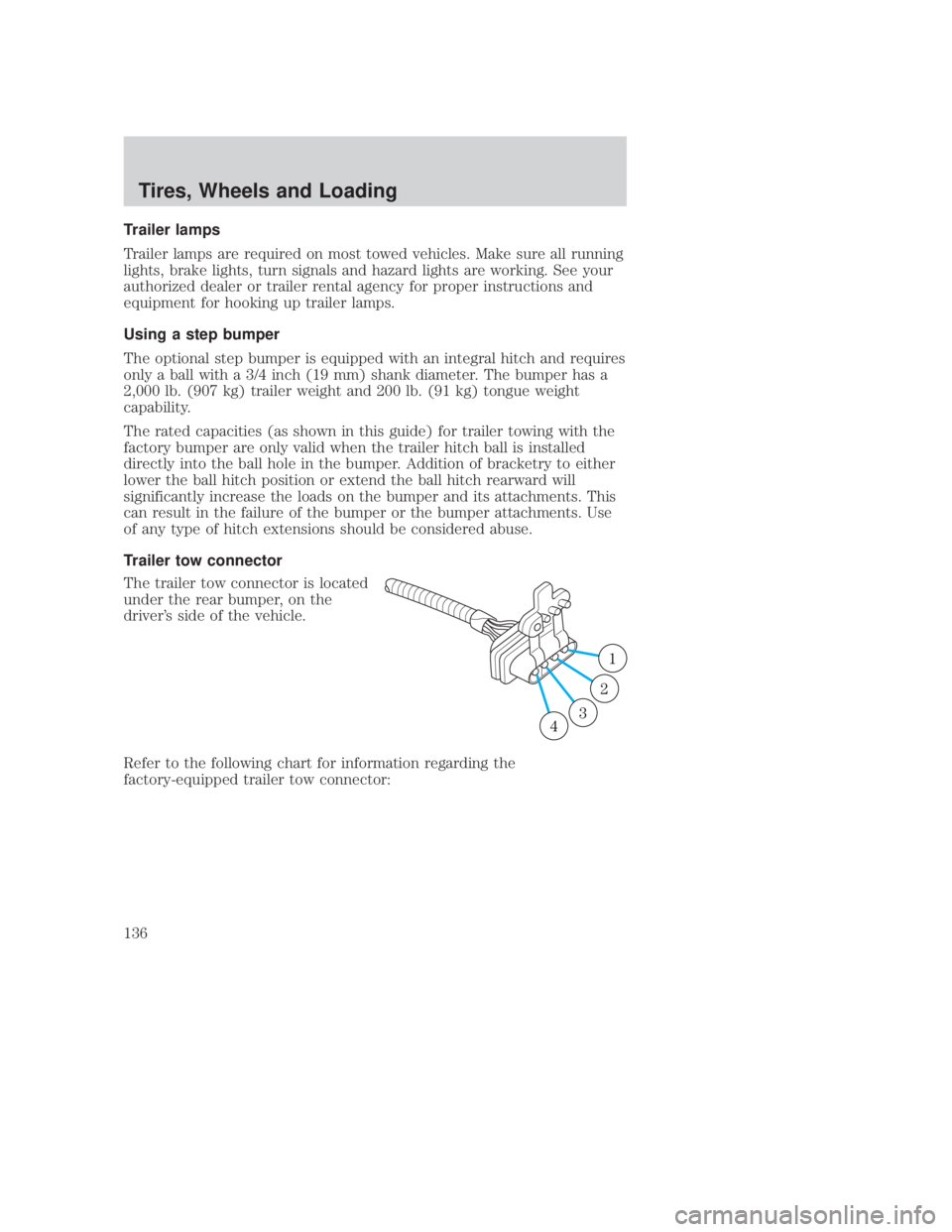
JOBNAME: No Job Name PAGE: 136 SESS: 1 OUTPUT: Thu Sep 15 08:22:27 2005
/ford_pdm/ford/own2002/mbs/og
Trailer lamps
Trailer lamps are required on most towed vehicles. Make sure all running
lights, brake lights, turn signals and hazard lights are working. See your
authorized dealer or trailer rental agency for proper instructions and
equipment for hooking up trailer lamps.
Using a step bumper
The optional step bumper is equipped with an integral hitch and requires
only a ball with a 3/4 inch (19 mm) shank diameter. The bumper has a
2,000 lb. (907 kg) trailer weight and 200 lb. (91 kg) tongue weight
capability.
The rated capacities (as shown in this guide) for trailer towing with the
factory bumper are only valid when the trailer hitch ball is installed
directly into the ball hole in the bumper. Addition of bracketry to either
lower the ball hitch position or extend the ball hitch rearward will
significantly increase the loads on the bumper and its attachments. This
can result in the failure of the bumper or the bumper attachments. Use
of any type of hitch extensions should be considered abuse.
Trailer tow connector
The trailer tow connector is located
under the rear bumper, on the
driver's side of the vehicle.
Refer to the following chart for information regarding the
factory-equipped trailer tow connector:
1
2
34
CIMS #81318
com_trailer-lampsitdseq=167
CIMS #710092
com_use-step-bumper.mbs itdseq=168
CIMS #476432
com_towconnect.ran itdseq=169
art=ranmc721_a
REVIEW COPY ÐÐ
2006 B-Series (mbs), Owners Guide (post-2002-fmt) (own2002),Market:USA(fus)
PAGE: 136OP:root EDIT SESSION: 1DATE: SEPT 15 2005 at 8:22JOB:@ibm2/ford_pdm/CLS_ford/GRP_own2002/JOB_mbs/DIV_og
Tires, Wheels and Loading
136
Page 148 of 266
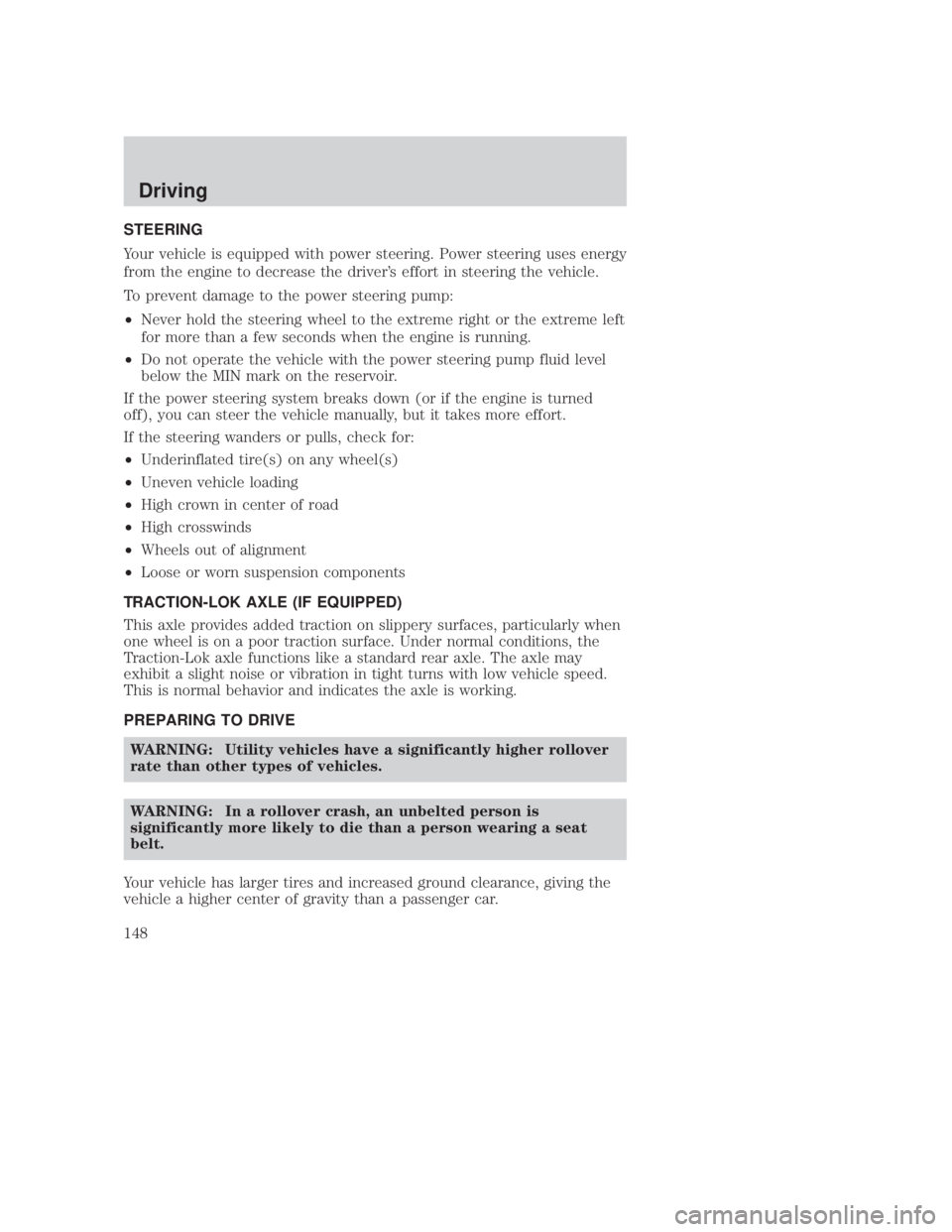
JOBNAME: No Job Name PAGE: 148 SESS: 1 OUTPUT: Thu Sep 15 08:22:27 2005
/ford_pdm/ford/own2002/mbs/og
STEERING
Your vehicle is equipped with power steering. Power steering uses energy
from the engine to decrease the driver's effort in steering the vehicle.
To prevent damage to the power steering pump:
²Never hold the steering wheel to the extreme right or the extreme left
for more than a few seconds when the engine is running.
² Do not operate the vehicle with the power steering pump fluid level
below the MIN mark on the reservoir.
If the power steering system breaks down (or if the engine is turned
off), you can steer the vehicle manually, but it takes more effort.
If the steering wanders or pulls, check for:
² Underinflated tire(s) on any wheel(s)
² Uneven vehicle loading
² High crown in center of road
² High crosswinds
² Wheels out of alignment
² Loose or worn suspension components
TRACTION-LOK AXLE (IF EQUIPPED)
This axle provides added traction on slippery surfaces, particularly when
one wheel is on a poor traction surface. Under normal conditions, the
Traction-Lok axle functions like a standard rear axle. The axle may
exhibit a slight noise or vibration in tight turns with low vehicle speed.
This is normal behavior and indicates the axle is working.
PREPARING TO DRIVE WARNING: Utility vehicles have a significantly higher rollover
rate than other types of vehicles.
WARNING: In a rollover crash, an unbelted person is
significantly more likely to die than a person wearing a seat
belt.
Your vehicle has larger tires and increased ground clearance, giving the
vehicle a higher center of gravity than a passenger car.CIMS #244756
com_steering.04 itdseq=189
CIMS #954505
com_axle-statement.fly itdseq=190
CIMS #954507
com_prep-to-drive.fly itdseq=191
REVIEW COPY ÐÐ
2006 B-Series (mbs), Owners Guide (post-2002-fmt) (own2002),Market:USA(fus)
PAGE: 148OP:root EDIT SESSION: 1DATE: SEPT 15 2005 at 8:22JOB:@ibm2/ford_pdm/CLS_ford/GRP_own2002/JOB_mbs/DIV_og
Driving
148
Page 155 of 266
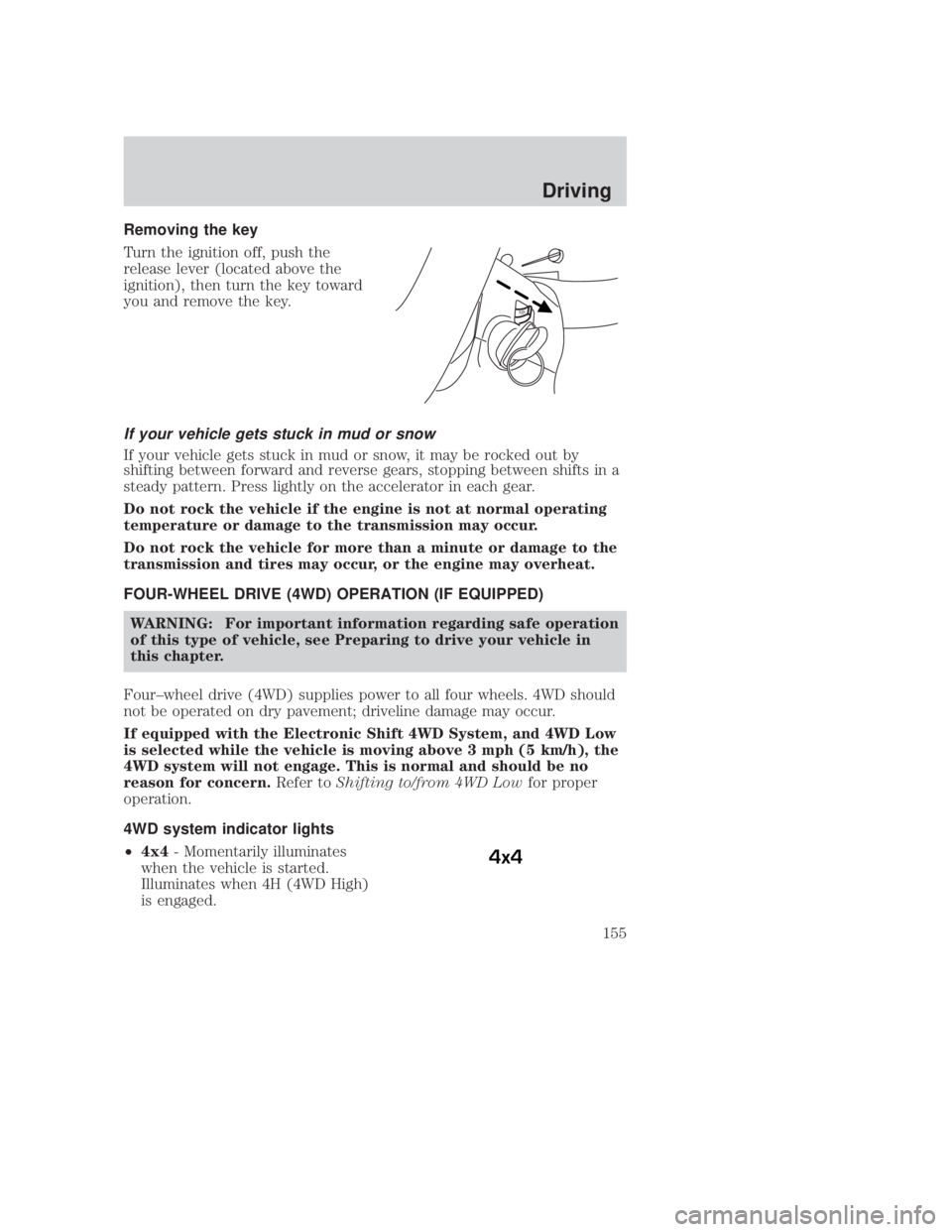
JOBNAME: No Job Name PAGE: 155 SESS: 1 OUTPUT: Thu Sep 15 08:22:27 2005
/ford_pdm/ford/own2002/mbs/og
Removing the key
Turn the ignition off, push the
release lever (located above the
ignition), then turn the key toward
you and remove the key.
If your vehicle gets stuck in mud or snow
If your vehicle gets stuck in mud or snow, it may be rocked out by
shifting between forward and reverse gears, stopping between shifts in a
steady pattern. Press lightly on the accelerator in each gear.
Do not rock the vehicle if the engine is not at normal operating
temperature or damage to the transmission may occur.
Do not rock the vehicle for more than a minute or damage to the
transmission and tires may occur, or the engine may overheat.
FOUR-WHEEL DRIVE (4WD) OPERATION (IF EQUIPPED)WARNING: For important information regarding safe operation
of this type of vehicle, see Preparing to drive your vehicle in
this chapter.
Four±wheel drive (4WD) supplies power to all four wheels. 4WD should
not be operated on dry pavement; driveline damage may occur.
If equipped with the Electronic Shift 4WD System, and 4WD Low
is selected while the vehicle is moving above 3 mph (5 km/h), the
4WD system will not engage. This is normal and should be no
reason for concern. Refer toShifting to/from 4WD Low for proper
operation.
4WD system indicator lights
² 4x4 - Momentarily illuminates
when the vehicle is started.
Illuminates when 4H (4WD High)
is engaged.
PUSH
4x4
CIMS #1035362
com_remove-key itdseq=200
CIMS #1058177
com_rocking-vehicle itdseq=201
CIMS #73625 com_four_wd itdseq=202
CIMS #1114726
com_4wd-lights.ran2003 itdseq=203
art=rangf114_a
art=f12ip031_a
REVIEW COPY ÐÐ
2006 B-Series (mbs), Owners Guide (post-2002-fmt) (own2002),Market:USA(fus)
PAGE: 155OP:root EDIT SESSION: 1DATE: SEPT 15 2005 at 8:22JOB:@ibm2/ford_pdm/CLS_ford/GRP_own2002/JOB_mbs/DIV_og
Driving
155
Page 159 of 266
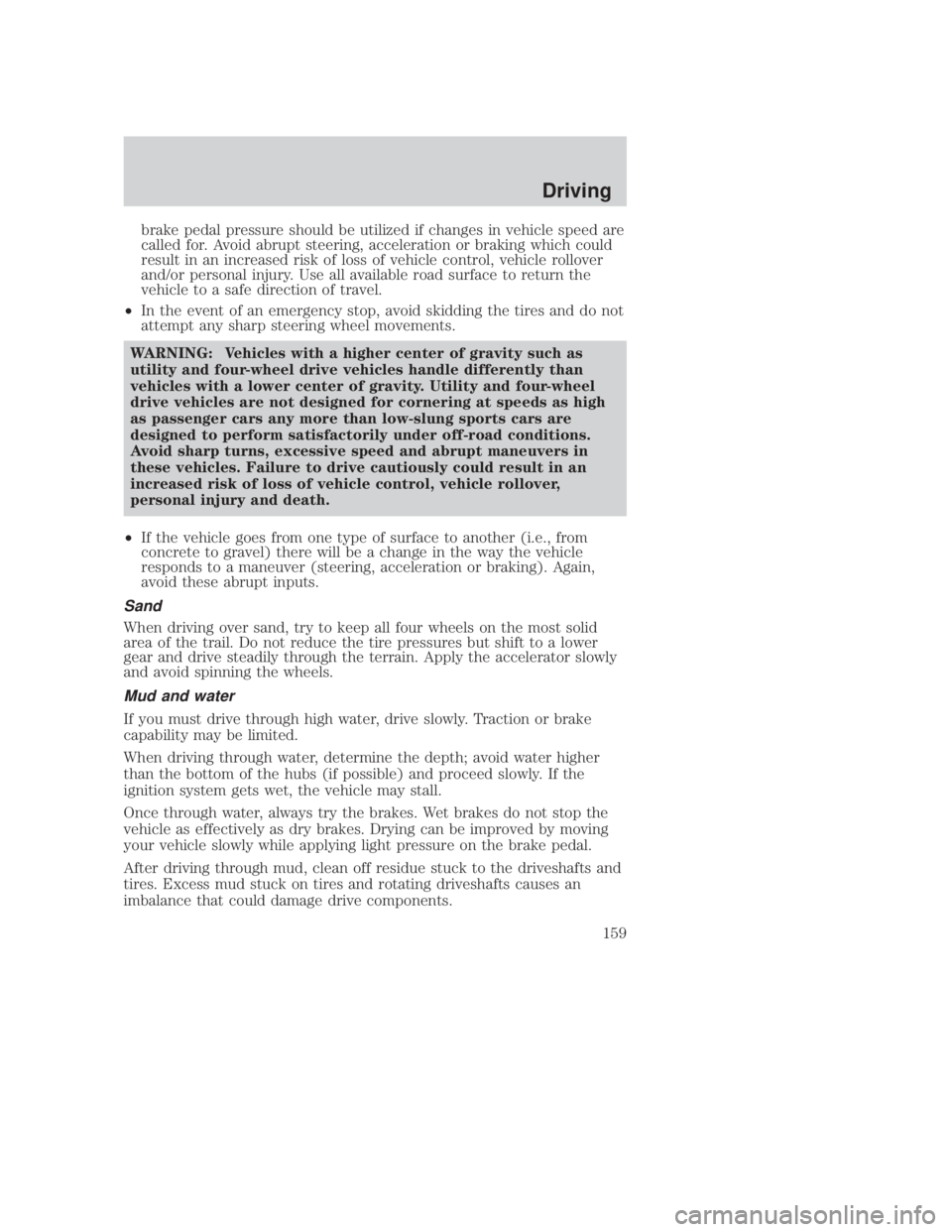
JOBNAME: No Job Name PAGE: 159 SESS: 1 OUTPUT: Thu Sep 15 08:22:27 2005
/ford_pdm/ford/own2002/mbs/og
brake pedal pressure should be utilized if changes in vehicle speed are
called for. Avoid abrupt steering, acceleration or braking which could
result in an increased risk of loss of vehicle control, vehicle rollover
and/or personal injury. Use all available road surface to return the
vehicle to a safe direction of travel.
² In the event of an emergency stop, avoid skidding the tires and do not
attempt any sharp steering wheel movements.
WARNING: Vehicles with a higher center of gravity such as
utility and four-wheel drive vehicles handle differently than
vehicles with a lower center of gravity. Utility and four-wheel
drive vehicles are not designed for cornering at speeds as high
as passenger cars any more than low-slung sports cars are
designed to perform satisfactorily under off-road conditions.
Avoid sharp turns, excessive speed and abrupt maneuvers in
these vehicles. Failure to drive cautiously could result in an
increased risk of loss of vehicle control, vehicle rollover,
personal injury and death.
² If the vehicle goes from one type of surface to another (i.e., from
concrete to gravel) there will be a change in the way the vehicle
responds to a maneuver (steering, acceleration or braking). Again,
avoid these abrupt inputs.
Sand
When driving over sand, try to keep all four wheels on the most solid
area of the trail. Do not reduce the tire pressures but shift to a lower
gear and drive steadily through the terrain. Apply the accelerator slowly
and avoid spinning the wheels.
Mud and water
If you must drive through high water, drive slowly. Traction or brake
capability may be limited.
When driving through water, determine the depth; avoid water higher
than the bottom of the hubs (if possible) and proceed slowly. If the
ignition system gets wet, the vehicle may stall.
Once through water, always try the brakes. Wet brakes do not stop the
vehicle as effectively as dry brakes. Drying can be improved by moving
your vehicle slowly while applying light pressure on the brake pedal.
After driving through mud, clean off residue stuck to the driveshafts and
tires. Excess mud stuck on tires and rotating driveshafts causes an
imbalance that could damage drive components.
REVIEW COPY ÐÐ
2006 B-Series (mbs), Owners Guide (post-2002-fmt) (own2002),Market:USA(fus)
PAGE: 159OP:root EDIT SESSION: 1DATE: SEPT 15 2005 at 8:22JOB:@ibm2/ford_pdm/CLS_ford/GRP_own2002/JOB_mbs/DIV_og
Driving
159
Page 174 of 266
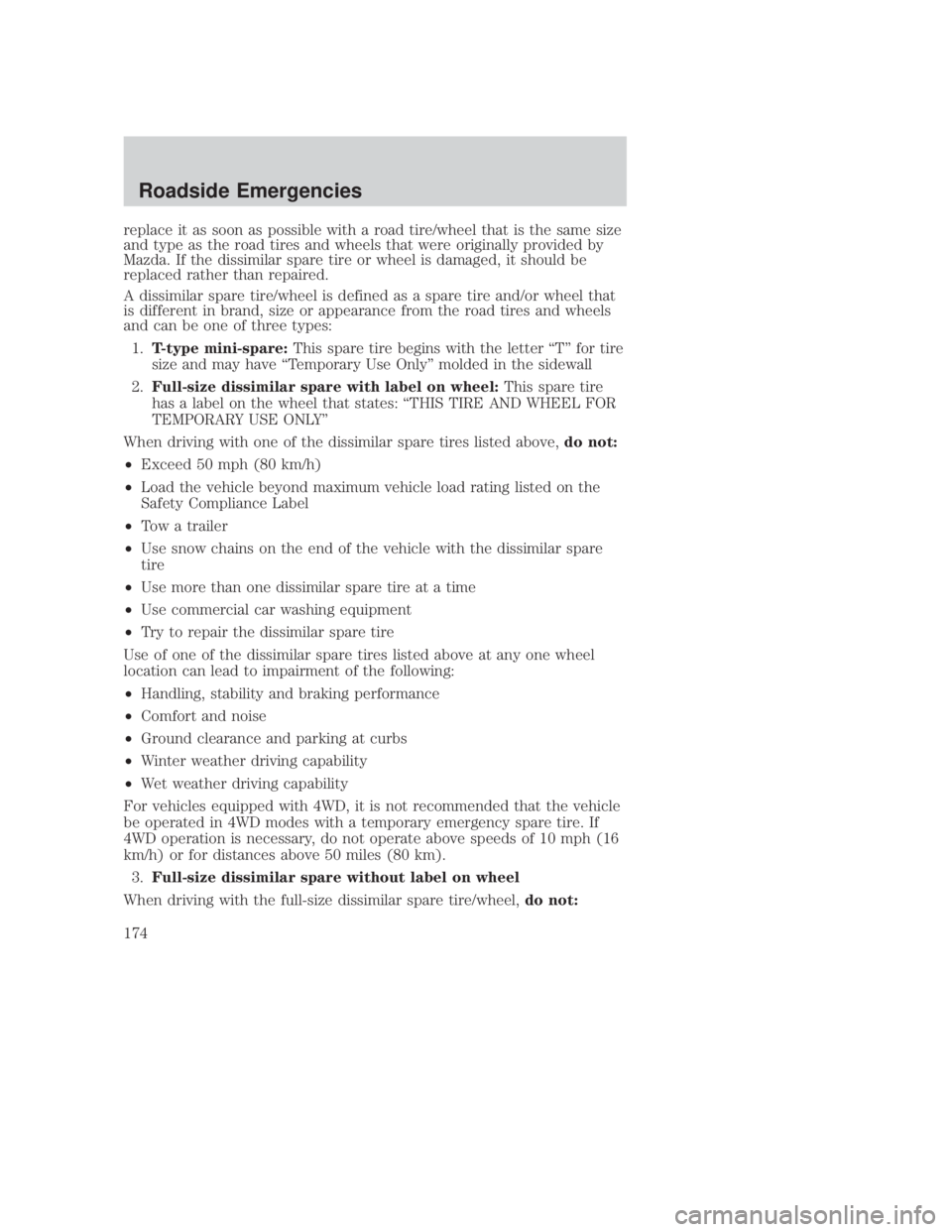
JOBNAME: No Job Name PAGE: 174 SESS: 1 OUTPUT: Thu Sep 15 08:22:27 2005
/ford_pdm/ford/own2002/mbs/og
replace it as soon as possible with a road tire/wheel that is the same size
and type as the road tires and wheels that were originally provided by
Mazda. If the dissimilar spare tire or wheel is damaged, it should be
replaced rather than repaired.
A dissimilar spare tire/wheel is defined as a spare tire and/or wheel that
is different in brand, size or appearance from the road tires and wheels
and can be one of three types:1. T-type mini-spare: This spare tire begins with the letter ªTº for tire
size and may have ªTemporary Use Onlyº molded in the sidewall
2. Full-size dissimilar spare with label on wheel: This spare tire
has a label on the wheel that states: ªTHIS TIRE AND WHEEL FOR
TEMPORARY USE ONLYº
When driving with one of the dissimilar spare tires listed above, do not:
² Exceed 50 mph (80 km/h)
² Load the vehicle beyond maximum vehicle load rating listed on the
Safety Compliance Label
² Tow a trailer
² Use snow chains on the end of the vehicle with the dissimilar spare
tire
² Use more than one dissimilar spare tire at a time
² Use commercial car washing equipment
² Try to repair the dissimilar spare tire
Use of one of the dissimilar spare tires listed above at any one wheel
location can lead to impairment of the following:
² Handling, stability and braking performance
² Comfort and noise
² Ground clearance and parking at curbs
² Winter weather driving capability
² Wet weather driving capability
For vehicles equipped with 4WD, it is not recommended that the vehicle
be operated in 4WD modes with a temporary emergency spare tire. If
4WD operation is necessary, do not operate above speeds of 10 mph (16
km/h) or for distances above 50 miles (80 km). 3. Full-size dissimilar spare without label on wheel
When driving with the full-size dissimilar spare tire/wheel, do not:
REVIEW COPY ÐÐ
2006 B-Series (mbs), Owners Guide (post-2002-fmt) (own2002),Market:USA(fus)
PAGE: 174OP:root EDIT SESSION: 1DATE: SEPT 15 2005 at 8:22JOB:@ibm2/ford_pdm/CLS_ford/GRP_own2002/JOB_mbs/DIV_og
Roadside Emergencies
174
Page 258 of 266
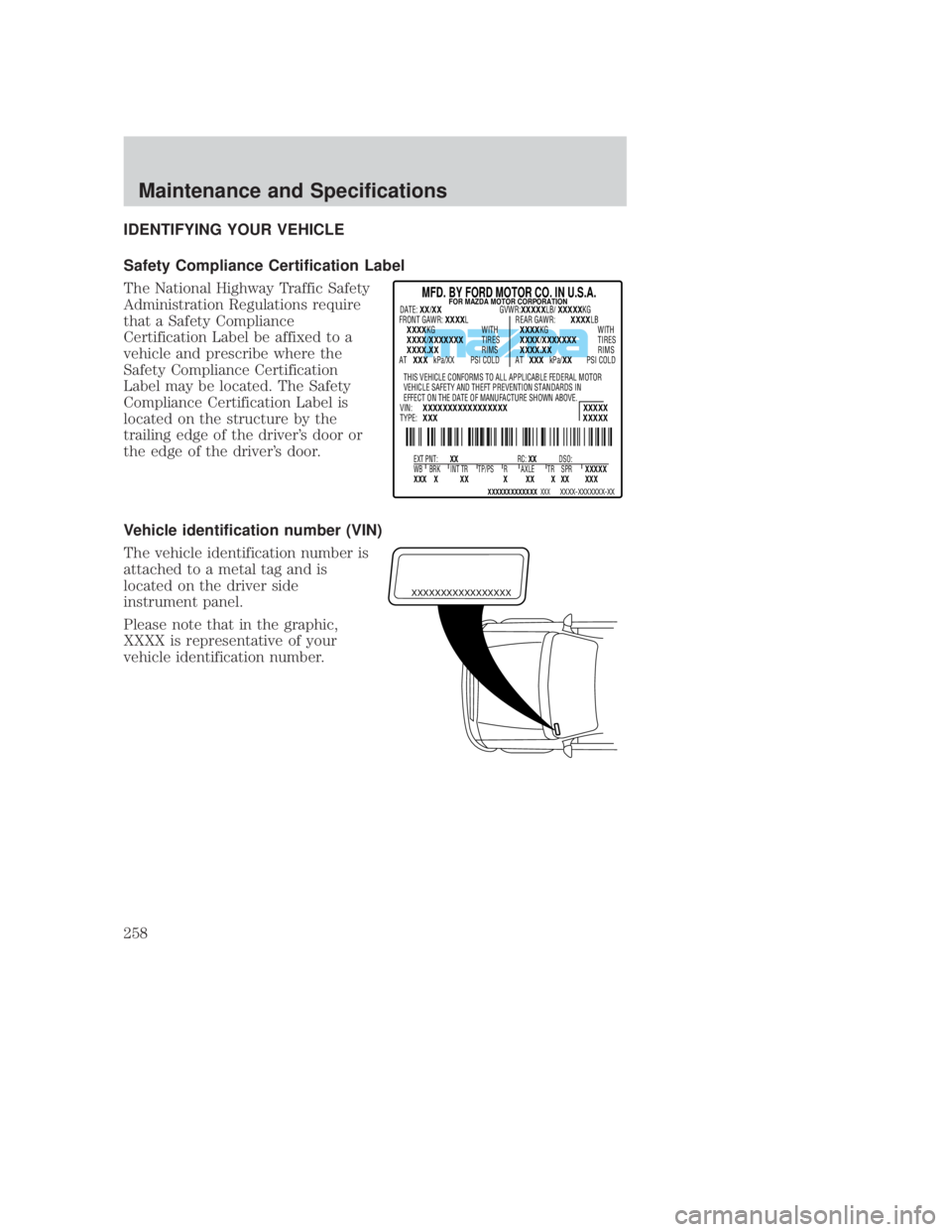
JOBNAME: No Job Name PAGE: 258 SESS: 1 OUTPUT: Thu Sep 15 08:22:27 2005
/ford_pdm/ford/own2002/mbs/og
IDENTIFYING YOUR VEHICLE
Safety Compliance Certification Label
The National Highway Traffic Safety
Administration Regulations require
that a Safety Compliance
Certification Label be affixed to a
vehicle and prescribe where the
Safety Compliance Certification
Label may be located. The Safety
Compliance Certification Label is
located on the structure by the
trailing edge of the driver's door or
the edge of the driver's door.
Vehicle identification number (VIN)
The vehicle identification number is
attached to a metal tag and is
located on the driver side
instrument panel.
Please note that in the graphic,
XXXX is representative of your
vehicle identification number.
MFD. BY FORD MOTOR CO. IN U.S.A.
EXT PNT:XX RC: XXDSO:
WB BRK INT TR TP/PS R AXLE TR SPR XXXXX
XXX X XX X XX X XX \
XXX
XXXXXXXXXXXXX XXX XXXX-XXXXXXX-XX
THIS VEHICLE CONFORMS TO ALL APPLICABLE FEDERAL MOTOR
VEHICLE SAFETY AND THEFT PREVENTION STANDARDS IN
EFFECT ON THE DATE OF MANUFACTURE SHOWN ABOVE.
VIN: XXXXXXXXXXXXXXXXX XXXXX
TYPE: XXX XXXXX
DATE: XX/XX GVWR:
XXXXXLB/ XXXXX KG
FRONT GAWR: XXXXL REAR GAWR: XXXXLB
AT XXX kPa/XX PSI COLD AT XXX kPa/XX PSI COLD
XXXXKG
WITH
XXXX/XXXXXXX TIRES
XXXX.XX RIMSXXXXKG
WITH
XXXX/XXXXXXX TIRES
XXXX.XX RIMS
FOR MAZDA MOTOR CORPORATION
XXXXXXXXXXXXXXXXX
CIMS #52653
com_vehicle-info.01
itdseq=322
CIMS #80651 com_vinplate itdseq=323
CIMS #72686
com_vin-numbers.02 itdseq=324
art=mazmc001_a
art=navmc710_a
REVIEW COPY ÐÐ
2006 B-Series (mbs), Owners Guide (post-2002-fmt) (own2002),Market:USA(fus)
PAGE: 258OP:root EDIT SESSION: 1DATE: SEPT 15 2005 at 8:22JOB:@ibm2/ford_pdm/CLS_ford/GRP_own2002/JOB_mbs/DIV_og
Maintenance and Specifications
258
Page 259 of 266
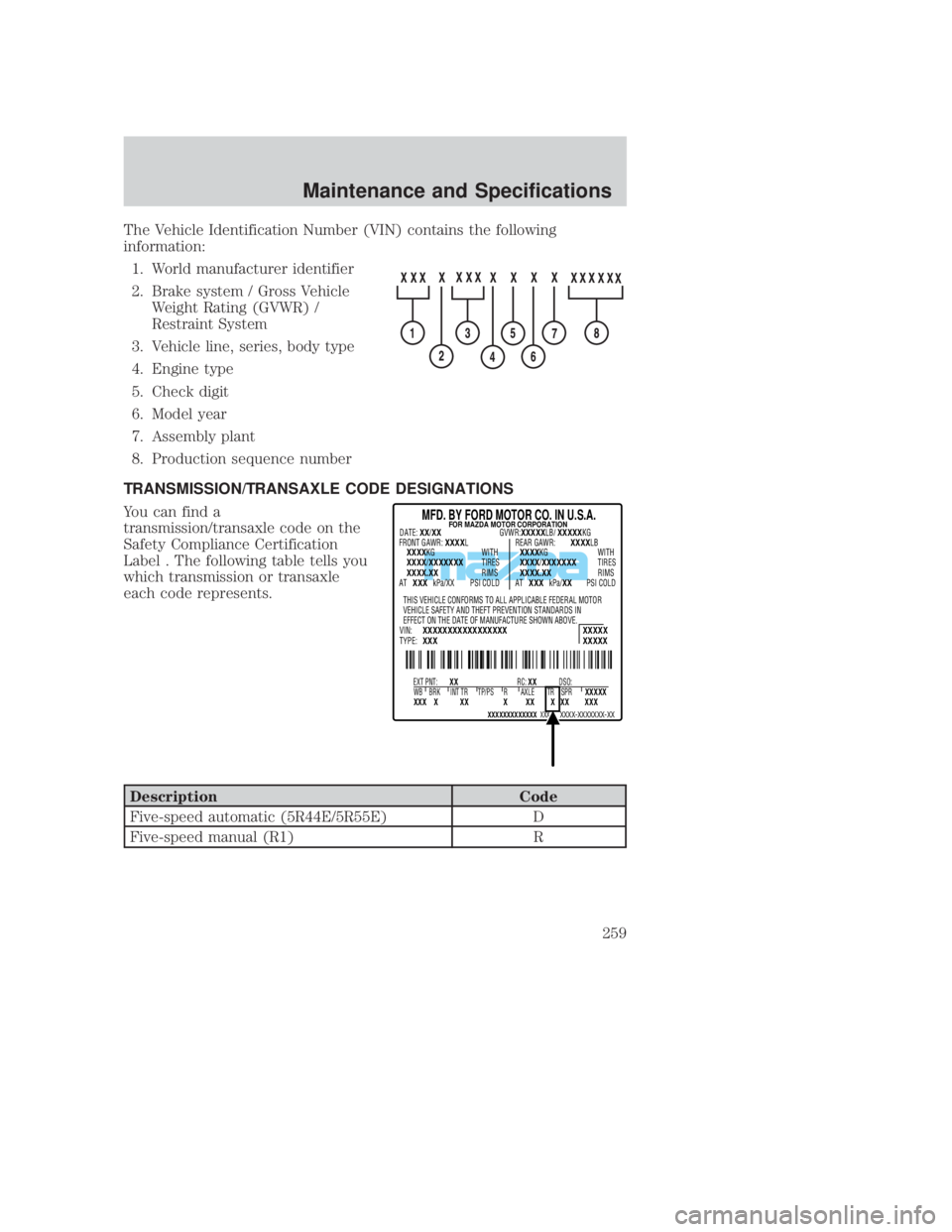
JOBNAME: No Job Name PAGE: 259 SESS: 1 OUTPUT: Thu Sep 15 08:22:27 2005
/ford_pdm/ford/own2002/mbs/og
The Vehicle Identification Number (VIN) contains the following
information:1. World manufacturer identifier
2. Brake system / Gross Vehicle Weight Rating (GVWR) /
Restraint System
3. Vehicle line, series, body type
4. Engine type
5. Check digit
6. Model year
7. Assembly plant
8. Production sequence number
TRANSMISSION/TRANSAXLE CODE DESIGNATIONS
You can find a
transmission/transaxle code on the
Safety Compliance Certification
Label . The following table tells you
which transmission or transaxle
each code represents.
Description Code
Five-speed automatic (5R44E/5R55E) D
Five-speed manual (R1) R
MFD. BY FORD MOTOR CO. IN U.S.A.
EXT PNT: XX RC: XXDSO:
WB BRK INT TR TP/PS R AXLE TR SPR XXXXX
XXX X XX X XX X XX \
XXX
XXXXXXXXXXXXX XXX XXXX-XXXXXXX-XX
THIS VEHICLE CONFORMS TO ALL APPLICABLE FEDERAL MOTOR
VEHICLE SAFETY AND THEFT PREVENTION STANDARDS IN
EFFECT ON THE DATE OF MANUFACTURE SHOWN ABOVE.
VIN: XXXXXXXXXXXXXXXXX XXXXX
TYPE: XXX XXXXX
DATE: XX/XX GVWR:
XXXXXLB/ XXXXX KG
FRONT GAWR: XXXXL REAR GAWR: XXXXLB
AT XXX kPa/XX PSI COLD AT XXX kPa/XX PSI COLD
XXXXKG
WITH
XXXX/XXXXXXX TIRES
XXXX.XX RIMSXXXXKG
WITH
XXXX/XXXXXXX TIRES
XXXX.XX RIMS
FOR MAZDA MOTOR CORPORATION
CIMS #734836
com_vin-info.all
itdseq=325
CIMS #1519411
com_trans-code.maz itdseq=326
CIMS #1498292
com_trans-code.mbs itdseq=327
art=204mc036_a
art=mazmc000_a
REVIEW COPY ÐÐ
2006 B-Series (mbs), Owners Guide (post-2002-fmt) (own2002),Market:USA(fus)
PAGE: 259OP:root EDIT SESSION: 1DATE: SEPT 15 2005 at 8:22JOB:@ibm2/ford_pdm/CLS_ford/GRP_own2002/JOB_mbs/DIV_og
Maintenance and Specifications
259
Page 265 of 266
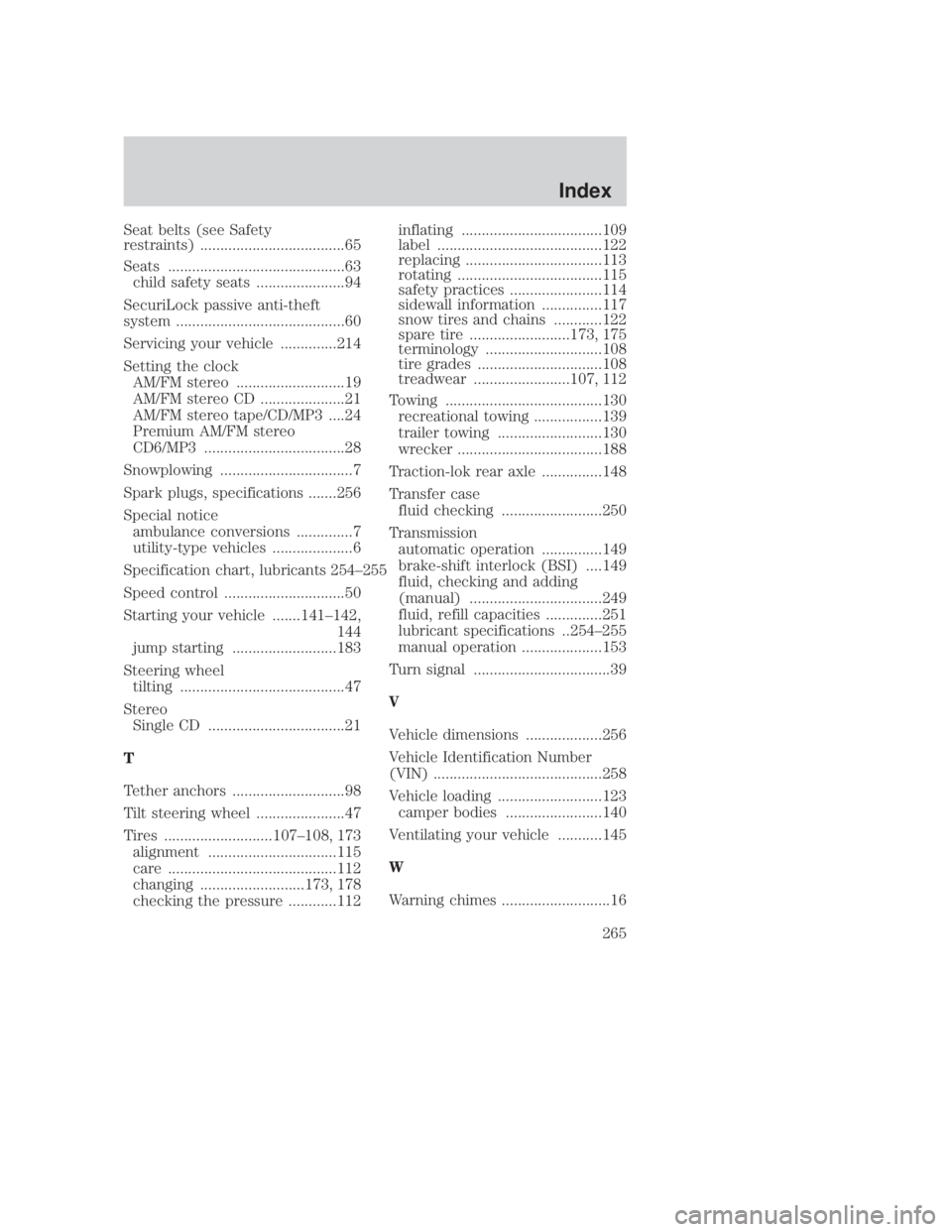
JOBNAME: No Job Name PAGE: 265 SESS: 3 OUTPUT: Thu Sep 15 08:22:27 2005
/ford_pdm/ford/own2002/mbs/og
Seat belts (see Safety
restraints) ....................................65
Seats ............................................63child safety seats ......................94
SecuriLock passive anti-theft
system ..........................................60
Servicing your vehicle ..............214
Setting the clock AM/FM stereo ...........................19
AM/FM stereo CD .....................21
AM/FM stereo tape/CD/MP3 ....24
Premium AM/FM stereo
CD6/MP3 ...................................28
Snowplowing .................................7
Spark plugs, specifications .......256
Special notice ambulance conversions ..............7
utility-type vehicles ....................6
Specification chart, lubricants 254±255
Speed control ..............................50
Starting your vehicle .......141±142, 144
jump starting ..........................183
Steering wheel tilting .........................................47
Stereo Single CD ..................................21
T
Tether anchors ............................98
Tilt steering wheel ......................47
Tires ...........................107±108, 173 alignment ................................115
care ..........................................112
changing ..........................173, 178
checking the pressure ............112 inflating ...................................109
label .........................................122
replacing ..................................113
rotating ....................................115
safety practices .......................114
sidewall information ...............117
snow tires and chains ............122
spare tire .........................173, 175
terminology .............................108
tire grades ...............................108
treadwear ........................107, 112
Towing .......................................130 recreational towing .................139
trailer towing ..........................130
wrecker ....................................188
Traction-lok rear axle ...............148
Transfer case fluid checking .........................250
Transmission automatic operation ...............149
brake-shift interlock (BSI) ....149
fluid, checking and adding
(manual) .................................249
fluid, refill capacities ..............251
lubricant specifications ..254±255
manual operation ....................153
Turn signal ..................................39
V
Vehicle dimensions ...................256
Vehicle Identification Number
(VIN) ..........................................258
Vehicle loading ..........................123 camper bodies ........................140
Ventilating your vehicle ...........145
W
Warning chimes ...........................16
REVIEW COPY ÐÐ 2006 B-Series (mbs), Owners Guide (post-2002-fmt) (own2002),Market:USA(fus)
PAGE: 265OP:root EDIT SESSION: 3DATE: SEPT 15 2005 at 8:22JOB:@ibm2/ford_pdm/CLS_ford/GRP_own2002/JOB_mbs/DIV_og
Index
265